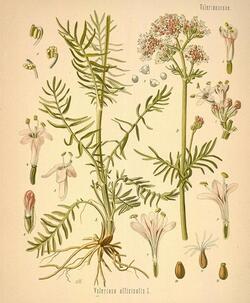Valerian-Valeriana Officinalis
image source:http://www.botanical.com/botanical/mgmh/v/valeri01.html
General
Its a hardy perennial flowering plant, with heads of sweetly scented pink or white flowers. The flowers are in bloom in the northern hemisphere from June to September. Valerian was used as a perfume in the sixteenth century. Native to Europe and parts of Asia, Valerian has been introduced into North America. It is consumed as food by the larvae of some Lepidoptera (butterfly and moth) species including Grey Pug. Other names used for this plant include garden valerian (to distinguish it from other Valeriana species), garden heliotrope (although not related to Heliotropium) and all-heal. The garden flower red valerian is also sometimes referred to as “valerian” but is a different species, from the same family but not particularly closely related.http://en.wikipedia.org/wiki/Valerian_%28herb%29
The roots tend to merge into a short, conical root-stock or erect rhizome, the development of which often proceeds for several years before a flowering stem is sent up, but slender horizontal branches which terminate in buds are given off earlier, and from these buds proceed aerial shoots or stolons, which produce fresh plants where they take root. Only one stem arises from the root, which attains a height of 3 or 4 fee.http://www.botanical.com/botanical/mgmh/v/valeri01.html
The plant prefers light (sandy), medium (loamy) and heavy (clay) soils. The plant prefers acid, neutral and basic (alkaline) soils. It cannot grow in the shade. It requires moist soil.It is in flower from June to August, and the seeds ripen from July to September. The flowers are hermaphrodite (have both male and female organs) and are pollinated by Bees, flies, beetles. http://www.pfaf.org/database/plants.php?Valeriana+officinalis
History
“..The derivation of the name of this genus of plants is differently given. It is said by some authors to have been named after Valerius, who first used it in medicine; while others derive the name from the Latin word valere (to be in health), on account of its medicinal qualities. The word Valeriana is not found in the classical authors; we first meet with it in the ninth or tenth century, at which period and for long afterwards it was used as synonymous with Phu or Fu; Fu, id est valeriana, we find it described in ancient medical works of that period. The word Valerian occurs in the recipes of the AngloSaxon leeches (eleventh century). Valeriana, Amantilla and Fu are used as synonymous in the Alphita, a mediaeval vocabulary of the important medical school of Salernum. Saladinus of Ascoli (about 1450) directs the collection in the month of August of radices fu, id est Valerianae. Referring to the name Amantilla, by which it was known in the fourteenth century, Professor Henslow quotes a curious recipe of that period, a translation of which runs as follows: 'Men who begin to fight and when you wish to stop them, give to them the juice of Amantilla id est Valeriana and peace will be made immediately.' Theriacaria, Marinella, Genicularis and Terdina are other old names by which Valerian has been known in former days. Another old name met with in Chaucer and other old writers is 'Setwall' or 'Setewale,' the derivation of which is uncertain. Mediaeval herbalists also called the plant 'Capon's Tail,' which has rather fantastically been explained as a reference to its spreading head of whitish flowers..” http://www.botanical.com/botanical/mgmh/v/valeri01.html
